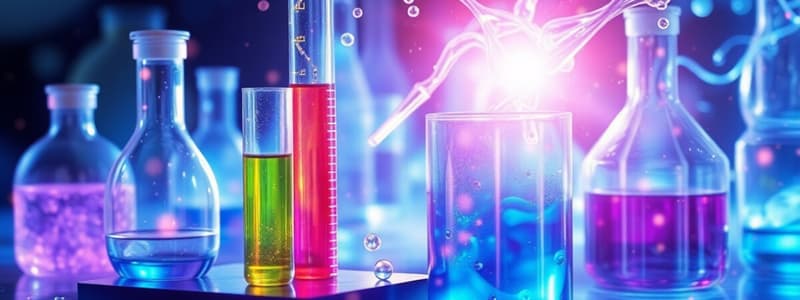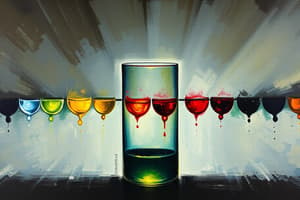Podcast
Questions and Answers
What principle does Thin Layer Chromatography (TLC) rely on for separating compounds?
What principle does Thin Layer Chromatography (TLC) rely on for separating compounds?
- Adsorption on a solid surface (correct)
- Centrifugal separation based on density
- Electrophoretic movement in a gel
- Differential solubility in a liquid
In what area is Column Chromatography primarily used?
In what area is Column Chromatography primarily used?
- Analyzing food additives and contaminants
- Separating drugs from biological fluids
- Purifying natural compounds and drug formulation (correct)
- Detecting pollutants in environmental samples
Which of the following best describes Partition Chromatography?
Which of the following best describes Partition Chromatography?
- Continuous partitioning into stationary and mobile phases (correct)
- Separation based solely on molecular size
- Adsorption on metallic surfaces
- Utilizing gas as the mobile phase for separation
Essential oils can be separated using which chromatography technique?
Essential oils can be separated using which chromatography technique?
Which application is NOT typical for Chromatography techniques?
Which application is NOT typical for Chromatography techniques?
What is a common real-life application of Thin Layer Chromatography (TLC)?
What is a common real-life application of Thin Layer Chromatography (TLC)?
Which component of plants is not typically analyzed using chromatographic techniques?
Which component of plants is not typically analyzed using chromatographic techniques?
What is the stationary phase in Column Chromatography?
What is the stationary phase in Column Chromatography?
What is the primary function of chromatography in biophysical analysis?
What is the primary function of chromatography in biophysical analysis?
Which of the following describes the stationary phase in chromatography?
Which of the following describes the stationary phase in chromatography?
Which of the following substances is commonly used as a mobile phase in chromatography?
Which of the following substances is commonly used as a mobile phase in chromatography?
What principle underlies paper chromatography?
What principle underlies paper chromatography?
Which type of chromatography separates compounds based on their absorptivity?
Which type of chromatography separates compounds based on their absorptivity?
What real-life application is commonly associated with paper chromatography?
What real-life application is commonly associated with paper chromatography?
What aspect of chromatography depends on the stationary phase selected?
What aspect of chromatography depends on the stationary phase selected?
Which of the following statements about mobile phases in chromatography is true?
Which of the following statements about mobile phases in chromatography is true?
What is adenosine triphosphate (ATP) primarily used for in cells?
What is adenosine triphosphate (ATP) primarily used for in cells?
Which component of ATP is responsible for its high-energy bonds?
Which component of ATP is responsible for its high-energy bonds?
What is the result of breaking the bond between the second and third phosphate groups of ATP?
What is the result of breaking the bond between the second and third phosphate groups of ATP?
What process occurs in the mitochondria to regenerate ATP from ADP?
What process occurs in the mitochondria to regenerate ATP from ADP?
In which reaction does ATP lose a phosphate group and release energy?
In which reaction does ATP lose a phosphate group and release energy?
What happens to ADP after it has lost its phosphate group?
What happens to ADP after it has lost its phosphate group?
What prevents the energy released during ATP hydrolysis from causing overheating in cells?
What prevents the energy released during ATP hydrolysis from causing overheating in cells?
What role does phosphocreatine play in relation to ATP?
What role does phosphocreatine play in relation to ATP?
Flashcards are hidden until you start studying
Study Notes
Chromatography
- Chromatography is a technique used to separate components of a mixture.
- It involves two phases: a stationary phase (solid or liquid) and a mobile phase (liquid or gas)
- Substances in the mixture interact differently with the stationary and mobile phases, causing them to separate.
Types of Chromatography
- Paper Chromatography: Separates substances based on their different affinities for the stationary phase (paper) and the mobile phase (solvent).
- Example: Separating pigments from a leaf extract.
- Real-Life Applications: Forensic science (analyzing inks, dyes, and drugs) and educational labs.
- Adsorption Chromatography: Separates substances based on their different adsorption rates to the stationary phase (adsorbent material like silica or alumina).
- Real-Life Applications: Pharmaceuticals (separating and purifying drugs), manufacturing (purifying industrial chemicals).
- Thin Layer Chromatography (TLC): Similar to paper chromatography, but a thin layer of adsorbent (silica or alumina) is coated on a plate.
- Example: Separating essential oils.
- Real-Life Applications: Pharmaceutical industry (purity testing and monitoring reactions), forensic labs (drug analysis).
- Column Chromatography: Separates substances based on their different adsorption rates to the stationary phase (adsorbent material) packed in a column.
- Example: Separating caffeine from a coffee extract.
- Real-Life Applications: Drug formulation, purification of natural compounds, separation of components of perfumes and essential oils, organic synthesis.
- Partition Chromatography: Separates substances based on their different solubility in the stationary phase (liquid) and mobile phase (liquid).
- Example: Paper chromatography, where the paper acts as the stationary phase and the mixture of solvents acts as the mobile phase.
- Real-Life Applications: Pharmaceutical industry (purification of drugs).
ATP Structure and Hydrolysis
- ATP (adenosine triphosphate) is a molecule used for energy storage and transport in cells.
- Composed of adenine (a nitrogenous base), ribose (a sugar), and three phosphate groups.
- The bonds between the phosphate groups are unstable and release energy when broken through hydrolysis.
- Hydrolysis of ATP produces ADP (adenosine diphosphate) and an inorganic phosphate group (Pi).
- The reaction is reversible: ATP + H2O → ADP + Pi + energy
ATP - ADP Cycle
- ATP → ADP: Energy is released when a phosphate group is removed.
- ADP → ATP: Energy is required to add a phosphate group.
- ATP can be produced from ADP at the mitochondria using ATP synthase.
ATP in Energy Coupling
- The energy released from ATP hydrolysis can be used to power cellular processes.
- This energy is coupled to other processes to avoid excessive heat release.
Studying That Suits You
Use AI to generate personalized quizzes and flashcards to suit your learning preferences.




